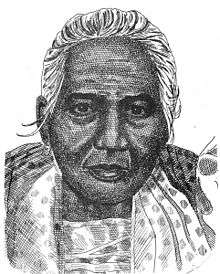Women in warfare and the military in the 19th century
Active warfare throughout history has mainly been a matter for men, but women have also played a role, often a leading one. While women rulers conducting warfare was common, women who participated in active warfare were very rare. The following is a list of women in war and their exploits from about 1800 up to about 1899.
For women in warfare in the United States at this time, please see Timeline of women in war in the United States, Pre-1945.
Only women active in direct warfare, such as warriors, spies, and women who actively led armies are included in this list.
Timeline of women in warfare in the 19th century worldwide (except the present US)
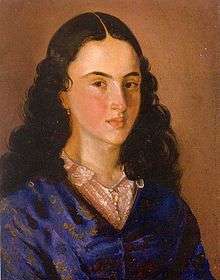
La Pola

Nehanda Nyakasikana
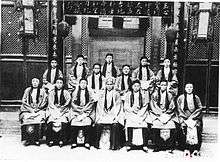
Lin Hei'er and the Red Lantern Unit
1800s
- Early 19th century: Geertrudia van den Heuvel serve as corporal in the Netherlands dressed as a man under the name Jacobus Philippus Vermeij.[1]
- 1802: Bùi Thị Xuân, the general of rebel forces during the Tây Sơn Rebellion in Vietnam, is captured and executed by her enemies.[2]
- 1802: Marie-Jeanne Lamartiniére, serves at the Battle of Crête-à-Pierrot.[3]
- 1802: Mai Sukhan defends the town of Amritsar against Ranjit Singh.[4][5]
- 1802: La Mulâtresse Solitude participates in the former slaves fight for freedom in the Battle of 18 May, when slavery is reintroduced on Guadeloupe by Napoleon.[6][7]
- 1803: Lorenza Avemanay leads a revolt against Spanish occupation in Ecuador.[8]
- 1803: Madame d'Oettlinger serves as a spy of Napoleon in Germany.[9]
- 1805: Jane Townsend serves in the Royal British marines during the Battle of Trafalgar.[10]
- 1806-1812: Virginie Ghesquière took her brother's place in the 27th Line regiment of Napoleon's army, serve during the Peninsular War under Andoche Junot, was promoted to lieutenant, [11] and in 1857 awarded the Saint Helena medal.[12]
- 1805: Marie-Jeanne Schellinck serve in the Battle of Austerlitz.[13]
- 1806: Manuela Pedraza fought in the reconquest of Buenos Aires after the first British invasions of the Río de la Plata.[14]
- 1807–1816: Nadezhda Durova serve in the Russian army. She earned the cross of St George for valour in combat and became the Russian army's first female officer.[15]
- 1808: Juana Galán was a guerrilla fighter of the Peninsular War (1808–1814).[16]
- 1808: Manuela Malasaña participated in The 2 May Uprising in Madrid (1808) against the troops of Napoleon I of France during the Peninsular War.[16]
- 1808: Agustina de Aragón defends Spain during the Spanish War of Independence.[17] During the bloody sieges of Saragossa, French General Jean-Antonie Verdier started the attack with a twenty-seven-hour bombardment of Zaragoza. At the Portillo Gate, most of the Spanish defenders had been killed or wounded, and on 2 July 1808 a French column launched an assault on the unmanned Portillo Gate battery. Observing the danger, twenty-two-year-old Agustina rushed forward to a twenty-four-pound cannon, retrieved the still-burning wick from the hands of a fallen gunner, and fired the cannon loaded with grapeshot at the advancing French column that decimated it and gave time to arrive Spanish reinforcements from a near battery to reject the attack. Agustina herself explained the facts in a memorial signed in Sevilla city in date 12 August 1810.
- 1808–1809: Elisa Servenius enlists in the Swedish army dressed as a man because "She had decided to live and to die with her husband", the soldier Bernhard Servenus; she participates in the war between Sweden and Russia about Finland, and during one battle, she collected the ammunition of the Russians and gave them to her comrades. She is later discovered, fired but decorated with a medal for bravery in battle.[18]
- 1809–1813: Joanna Żubr serve in the Polish army.[19] She received the Virtuti Militari, the first woman to be granted the highest Polish military award.
- 1809–1825: Juana Azurduy de Padilla acts as a guerrilla leader in Bolivia.[20]
1810s
- 1810s: Juana Ramírez commands a group of female rebel soldiers during the Venezuelan War of Independence.[21]
- 1810, Sweden: Maria Nilsdotter i Ölmeskog dissolves a potential rebel army and are rewarded by the monarch for having prevented a rebellion.[22]
- 1811–1817: Gertrudis Bocanegra serves as a spy, a messenger and a guerrilla fighter during the Mexican War of Independence.[23]
- 1811–1817: María Martínez provides reports as a spy to the rebel army during the Mexican War of Independence. She is fined and jailed several times, and is eventually executed.[24]
- 1812: Vasilisa Kozhina leads a Russian partisan group against Napoleon.[25]
- 1812: Marie Manuel and her husband Blaise Peuxe serve together as gunners in a French artillery unit during the Peninsular War. They are captured together when the British Army enters Madrid in August 1812, and become prisoners of war in Scotland, where Marie is officially acknowledged as an enemy combatant rather than simply a camp follower, wearing uniform and avoiding the forcible repatriation imposed on other prisoners' attendant families. The memoirs of another prisoner hint that she was a Spanish girl who had met her husband when she saved him from guerrillas in 1811, but this source may combine the story of the husband-and-wife gunners with elements of the biographies of other female prisoners-of-war in the same group.[26]
- 1812–1814: Francina Broese Gunningh serve in the French, the Prussian and finally in the Dutch army dressed as a male under the name Frans Gunningh Sloet.[27][28]
- 1813: Eleonore Prochaska killed fighting for the Lützow Free Corps.[29]
- 1813: Manuela Medina participates in active warfare in the Battle of Acapulco during the Mexican War of Independence.[30]
- 1813–1815: Anna Lühring[31] and Friederike Krüger[32] serve in the Prussian army during the Napoleonic Wars.
- 1813: Johanna Stegen participate in the defense of the city of Lüneburg against the French.[33]
- 1814: Ghaliyya al-Wahhabiyya defend Mecca against the Ottomans with her own Wahhabi army at the Battle of Turaba.[34]
- 1814: Úrsula Goyzueta participate in the defense of Santa Barbara the Bolivian War of Independence.[35]
- 1815: William Brown (birth name unknown), a Royal Navy sailor, is discovered to be a woman. She is the first black woman to serve in the Royal Navy.[36]
- 1815: Several women are found dead in British uniforms after the Battle of Waterloo, among them Mary Dixon, who dies in service after having served sixteen years in the British army dressed as a man.[37]
- 1817: La Pola is executed by the Spanish after having served as a spy during the Colombian war of Independence.[38]
- 1817: Martha Christina Tiahahu fights against the Dutch colonial government in Molucca, Indonesia.[39][40][41]
- 1819: Manono II, fought along with her husband Keaoua Kekuaokalani, in the Battle of Kuamoo, where both perished in defense of the kapu system.[42]
- 1819: María Antonia Santos Plata, a Neogranadine (now Colombia) peasant, galvanized, organized, and led the rebel guerrillas in the Province of Socorro against the invading Spanish troops during the Reconquista of the New Granada; she was ultimately captured, tried, and found guilty of lese-majesty and high treason, sentenced and ultimately put to death by firing squad.[43]
1820s
- 1821–1824: Laskarina Bouboulina fights in the Greek War of Independence.[44]
- 1821–1823: Manto Mavrogenous fights in the Greek War of Independence.[45]
- 1821: Rallou Karatza participates in the Greek war of Independence.[46]
- 1822: Angélique Brûlon, a female soldier who had in defence of Corsica from 1792–1799, is promoted to lieutenant. She had originally fought while disguised as a man, but eventually fought openly as a woman. She retires the same year.[47]
- 1822: Maria Quitéria fights in the Brazilian war of independence.[48]
- 1824: Queen Kittur Chennamma of the Kittur kingdom in India fights the British.
- 1828–1830: Tarenorerer leads a guerrilla band of Indigenous Australians of both sexes against the British colonists in Tasmania.[49]
1830s
- 1831–32: Countess Emilia Plater compose and command a company of Infantry as captain during the Polish November uprising.[50]
- 1838–1839: Johanna Martens serve in the Dutch army dressed as a man to be near to her lover, a soldier.[51]
- 1838-1840: African slave trader magnate Mary Faber de Sanger conduct warfare with her private army against her rival William Ormond in Bangalan.[52]
- 20 January 1839: Sergeant Candelaria Perez fights in the Battle of Yungay.[53]
1840s
- 1841: Ana María Martínez de Nisser participated in the Battle of Salamina 5 May 1841 during the War of the Supremes.[54]
- 1842: African slave trader magnate Mary Faber de Sanger conducts warfare with her private army against the British and their allies the Susu tribe with her ally Elizabeth Bailey Gomez, and plunder the Susu capital. [55]
- 1843: The slave Carlota was one of the three leaders of the slave rebellion of Year of the Lash on Cuba.[56]
- 1844–1846: María Trinidad Sánchez participate as a courier in the Dominican War of Independence.
- 1848: Luisa Battistati defends Milan during the Revolution of 1848.[57]
- 1848: Luise Aston serves in the Freikorps during the war in Schleswig.[58]
- 1848: Mária Lebstück (1831–1892) was a Hussar officer during the Hungarian War of Independence of 1848 and 1849 under the name Károly Lebstück.[59]
- 1848: Pelaghia Roşu commands a battalion of females in defense of her village during the failed revolutionary attempt.[60]
- 1848: Paulina Pfiffner serve in the Hungarian forces dressed as a man under the name Ligeti Kalman during the Hungarian Revolution of 1848 and is promoted to the rank of officer after having distinguished herself by her bravery during the Battle of Piski.
- 1848: Júlia Bányai serve as a spy as well as a soldier in the Hungarian army during the Hungarian Revolution of 1848.[61]
1850s
- 1850s: Su Sanniang joins the Taiping Rebellion with her army of outlaws and commands them in combat against the Imperial forces.[62]
- 1850s: Qiu Ersao commands 500 female rebel soldiers against the Imperial forces during the Taiping Rebellion.[62]
- 1850s: Hong Xuanjiao commands the female units of the rebel army against the Imperial forces during the Taiping Rebellion.[62]
- 1851: Júlia Bányai participates in the uprising against Austria in Transylvania.[61]
- 1851: Seh-Dong-Hong-Beh of the Dahomey Amazons is documented.[63]
- 1852-1855: The African slave traders Mary Faber de Sanger and Elizabeth Bailey Gomez conducts warfare against the British and their allie the Susus tribe with their private armies.[64]
- 1854: Florence Nightingale (a British nurse) revolutionised both the care of sick soldiers in the Crimean War, and also expectations of the role of women of her status.[65][66]
- 1856: Pancha Carrasco takes part in the Second Battle of Rivas in Costa Rica. While serving the militia as a cook and impromptu medic, filled her apron pockets with bullets, grabbed a discarded rifle and shamed some of the retreating Costa Ricans forestalling what might have become a rout.[67]
- 1857: Last stand of Lalla Fatma N'Soumer, an Algerian woman who resisted French colonialism.[68]
- 1857–1858: Indian queen Rani of Jhansi leads battles against the British. A member of her army, Indian resistance leader Jalkari Bai, defends Jhansi fort against the British.[69]
- 1857–1858: Begum Hazrat Mahal leads a band of her supporters against the British in the Indian rebellion of 1857.[70][71][72][73][74][75]
- 1858, 28 March: After personally leading a campaign against the British to regain her throne from them, Avantibai of the Indian state of Ramgarth kills herself when defeat seems imminent.[76]
1860s
- 1863: Anna Henryka Pustowojtowna fights in the Polish uprising dressed as a man.[77]
- 25 July 1865: Retired military Inspector General, H.M. Army Hospitals, Doctor James Barry, dies. Upon inspection of the corpse, it is discovered that Barry was in fact, female assigned at birth.[78]
- 1865: Jovita Feitosa joins the Brazilian army during the Paraguayan War.[79]
- 1867-1870: Du Fengyang commands her own rebel army during the Panthay rebellion in China.[80]
- October 1868: In Japan, Nakano Takeko and a group of other women take part in the Battle of Aizu.[81]
1870s
- 1870: Jane Dieulafoy serve as a soldier in the French army alongside her spouse dressed as a man during the Franco-Prussian war.[82]
- 1873-1876: The Duch deaconess Jeanne Merkus dress like a man and leads her own group of rebel warriors within the rebel gerilla of Mićo Ljubibratić, who fights the Turks in Herzegovina, and is dubbed the "Joan of Arc of the Balkans" in the international press.[83]
- 1877: Nene Hatun fought against Russian forces during the recapture of Fort Aziziye in Erzurum from Russian forces at the start of the Russo-Turkish War of 1877–1878.[84]
- 1879: Irene Morales serve in the Chilean army during the War of the Pacific dressed as a man.[85]
- 1879: Filomena Valenzuela Goyenechea serve in the Chilean army during the Battle of Pisagua, Battle of Dolores and Battle of Los Ángeles during the War of the Pacific.[86]
1880s
- 1880: Malalai of Maiwand rallies local Pashtun fighters at the Battle of Maiwand during the Second Anglo-Afghan War.[87] She fought alongside Ayub Khan and was responsible for the Afghan victory.[88]
- 1881: Antonia Moreno Leyva accompanies her spouse on the Breña campaign during the War of the Pacific, and actively commands battalions during his absence.[89]
- 1883: Marieta de Veintemilla, the niece and first lady of president Ignacio de Veintemilla, takes control of the capital, the government and its military forces in the name of her absent uncle and commands the defense of the capital of Quito when it is attacked by the rebels.[90]
- 1885: Yona Markova serve in the Bulgarian army dressed as a man during the Serbo-Bulgarian War.[91]
- 1885: Women started serving with the Canadian military in 1885, as nurses.[92]
1890s
- 1 March 1896: Taytu Betul marches to the Battle of Adwa with the Ethiopian imperial army, and commands a force of cannonners.[93]
- 1896: Philippine Revolution breaks out. Filipina woman Melchora Aquino becomes known as the "Grand Woman of the Revolution" and the "Mother of Balintawak" for her direct assistance to the revolutionaries.[94][95] Teresa Magbanua also takes part, fighting against the Spanish,[96] [97] and later fighting against American colonial forces during the Philippine–American War.[98]
- 1896: Shona spiritual leader Nehanda Nyakasikana rebels against colonization of Zimbabwe.[99]
- 1899–1900: Lin Hei'er commands the Red Lantern Unit of women rebel soldiers during the Boxer Rebellion.[62]
References
- djr (20 March 2017). "Digitaal Vrouwenlexicon van Nederland". www.historici.nl.
- Turner, Karen (2008). "Bui Thi Xuan". The Oxford Encyclopedia of Women in World History. Oxford University Press. p. 265. ISBN 978-0-19-514890-9.
- Webmaster. "Femmes d'Haiti : Marie-Jeanne". www.haiticulture.ch.
- Bhagata, Siṅgha (1993). A History of the Sikh Misals. Punjabi University. p. 197.
- Chhabra, G. S. (1972). Advanced History of the Punjab, vol 2: Ranjit Singh & post Ranjit Singh period (2 ed.). Punjab: New Academic Publishing Company. p. 106.
- "20 mai 1802 - Bonaparte légalise l'esclavage - Herodote.net". www.herodote.net.
- "Archived copy". Archived from the original on 3 January 2011. Retrieved 24 June 2015.CS1 maint: archived copy as title (link)
- The Northeastern Dictionary of Women's Biography: Revised by Maggy Hendry
- Wilhelmina Stålberg (Swedish): Anteqningar om Svenska kvinnor (Notes on Swedish women)
- Lincoln P. Paine: Warships of the World To 1900. p. 48. Retrieved 6 October 2014.
- Bernard A. Cook (2006). Women and War: A Historical Encyclopedia from Antiquity to the Present. ABC-CLIO. p. 229. ISBN 978-1-85109-770-8.
- A. Forrest, K. Hagemann, J. Rendall: Soldiers, Citizens and Civilians: Experiences and Perceptions
- Léonce Grabilier: Jeanne Schellinck in: L'Intermédiaire des chercheurs et curieux (frz.), 1909
- Lily Sosa de Newton (1980). "Diccionario Biográfico de Mujeres Argentinas" ("Biographic Dictionary of Argentine Women"). Plus Ultra: Buenos Aires. (Spanish)
- Durova, Nadezhda, The Cavalry Maiden: Journals of a Russian Officer in the Napoleonic Wars trans. Mary Fleming Zirin. Indiana University Press, 1989. ISBN 0-253-20549-2
- Rudorff, Raymond (1974) War to the death: the sieges of Saragossa, 1808–1809, p. 101. Hamilton. At Google Books. Retrieved 25 August 2013.
- Queralt del Hierro, María Pilar, Agustina de Aragón, la mujer y el mito, Madrid, La Esfera de los Libros, 2008.
- Cecilia af Klercker (översättning och redigering) (1942). Hedvig Elisabeth Charlottas dagbok VIII. P.A. Norstedt & Söners förlag.
- Encyklopedia Wojen Napoleońskich – R. Bielecki ("Encyclopedia of the Napoleonic Wars" in Polish)
- Pallis, Michael Slaves of Slaves: The Challenge of Latin American Women (London: Zed Press, 1980) pg. 24
- Boothroyd, Rachael (23 October 2015). "First Black Woman Independence Fighter is Honoured in Venezuela's National Mausoleum". venezuelanalysis.com. Retrieved 7 November 2015.
- Hedvig Elisabet Charlotta; Klercker Cecilia af (1942). Hedvig Elisabeth Charlottas dagbok. 9, 1812–1817. Stockholm: Norstedt. p. 689
- (Spanish) "Bocanegra de Lazo de la Vega, Gertrudis," Enciclopedia de México, v. 2. Mexico City, 1988.
- Notable Latin American Women: Twenty-nine Leaders, Rebels, Poets, Battlers and Spies. McFarland & Co. 1995. p. 137.
- Creatures - Page 138 Leonid Tishkov - 1994
- Ian MacDougall, All Men are Brethren: French, Scandinavian, Italian, German, Dutch, Belgian, Spanish, Polish, West Indian, American, and Other Prisoners of War in Scotland, 1803–1814 (John Donald, Edinburgh 2008), pp. 162–64, 227, 723–24
- "Gunningh Sloet, Francina (ca. 1792-na 1814)".
- Rudolf Dekker en Lotte van de Pol, Vrouwen in mannenkleren. De geschiedenis van een tegendraadse traditie. Europa 1500–1800 (Amsterdam 1989)
- Berlinische Nachrichten von Staats- und gelehrten Sachen (in German) (120). 7 October 1813
- Secretaría de Educación Pública. Comisión Nacional de Libros de Texto Gratuitos. (2007) (en español). Historia. Cuarto Grado. ISBN 978-968-01-1655-3.
- (German) Herbert Schwarzwälder: Berühmte Bremer. Paul-List-Verlag, Munich 1976, ISBN 3-471-78718-6, S. 62–70.
- Anita Heiden-Berndt: Friederike Auguste Krüger. Historisch-biographischer Roman. Neubrandenburg, 1994. ISBN 3-910170-16-1
- Germany in the Modern World: A New History By Sam A. Mustafa p.103
- Vassiliev, Alexei (2000). The History of Saudi Arabia. NYU Press. ISBN 978-0814788097. (Chapter 5).
- Roca, José Luis (2007). Ni con Lima ni con Buenos Aires: la formación de un estado nacional en Charcas. Plural editores. ISBN 978-999-541-076-6.
- "Jane Tars:The Women of the Royal Navy" by Susan Lucas from Aboutnelson.co.uk, last accessed 12 February 2006
- Isabelle Baudino; Jacques Carré; Marie-Cécile Révauger (2005). The Invisible Woman: Aspects of Women's Work in Eighteenth-century Britain. Ashgate. p. 82. ISBN 978-0-7546-3572-7.
- Adams, Jerome R. (1995). "8, La Pola". Notable Latin American Women. Jefferson, North Carolina: McFarland & Company. pp. 75–82. ISBN 978-0-7864-0022-5. OCLC 31328416.
- Tunny, Azis (27 April 2008). "Martha Christina Tiahahu: The 'kabaressi' heroine of Maluku". The Jakarta Post. Jakarta. Archived from the original on 27 December 2011. Retrieved 27 December 2011.
- Alaidrus, Syarivah (27 April 2010). "Martha Christina Si Pemberani dari Timur" [Martha Christina, the Brave One from the East]. Kompas (in Indonesian). Jakarta. Archived from the original on 27 December 2011. Retrieved 27 December 2011.
- Azizah, Jiz (2011). Wanita-Wanita Perkasa dari Jawa [The Gallant Women from Java] (in Indonesian). Bantul: IN AzNa Books. ISBN 978-979-3194-96-7.CS1 maint: ref=harv (link)
- Ellis, William (1827). Narrative of a Tour through Hawaii (2 ed.). London: H. Fisher, son, and P. Jackson.
- Horacio Rodríguez Plata, Biblioteca de historia nacional : Antonia Santos Plata: genealogía y biografía, vol. 110, Academia Colombiana de Historia, 1969, 261 p.
- Jennifer S. Uglow,Maggy Hendry. The Northeastern dictionary of women's biography. UPNE, 1999 ISBN 978-1-55553-421-9, p. 81: "Greek freedom fighter."
- Fodor's Essential Greek Islands: with Great Cruises & the Best of Athens By Fodor's Travel Guides
- Jennifer S. Uglow,Maggy Hendry. The Northeastern dictionary of women's biography. UPNE, 1999 ISBN 978-1-55553-421-9
- Jean-Loup Avril 1000 Bretons: dictionnaire biographique- 2002 – Page 133 "Marie-Angélique Duchemin quitte l'armée, puis est admise à l'Hôtel des Invalides où elle passera 61 ans. ... Ce ne sera que par décret du 15 août 1851 à l'occasion de la fête impériale que Marie-Angélique Duchemin, veuve Brulon, figurera ..."
- Brazilian biographical annual, Volume 2 By Joaquim Manoel de Macedo, p. 493–496
- Australian Dictionary of Biography
- Stefan Kieniewicz, Emilia Plater, Polski Słownik Biograficzny, Tom XXVII, Zakład Narodowy Imenia Ossolińskich I Wydawnictwo Polskieh Akademii Nauk, 1983, p.652
- djr (20 March 2017). "Digitaal Vrouwenlexicon van Nederland". www.historici.nl.
- Mouser, Bruce L. (17 October 1980). "Women Traders and Big-Men of Guinea-Conakry" (PDF). tubmaninstitute.ca. Tubman Institute. pp. 6–8. Archived from the original (PDF) on 9 August 2017. Retrieved 15 July 2019.
- Valdivia, Francisca (4 July 2011). "La importancia de la mujer en la guerra de 1879 a 1884" (in Spanish). Universidad Católica Silva Henríquez. Retrieved 28 January 2014.
- Restrepo, José Manuel (1952). Historia de la Nueva Granada. Bogotá: Editorial Cromos.
- Mouser, Bruce L. (17 October 1980). "Women Traders and Big-Men of Guinea-Conakry" (PDF). tubmaninstitute.ca. Tubman Institute. pp. 6–8. Archived from the original (PDF) on 9 August 2017. Retrieved 15 July 2019.
- Ana Lucia Araujo. Shadows of the Slave Past: Memory, Heritage and Slavery (Routledge Studies in Cultural History). Routledge, 2014. p. 198. ISBN 978-1-135-0119-70.
- Adams, Henry Gardiner, ed. (1857). A Cyclopaedia of Female Biography. London: Groombridge. p. 94.
- Gunhild Kyle and Eva von Krusenstjerna: Kvinnoprofiler (Female profiles) (1993) Norstedts Tryckeri AB Stockholm (Swedish)
- Benda: Lebstück Maria. In: Österreichisches Biographisches Lexikon 1815–1950 (ÖBL). Band 5, Verlag der Österreichischen Akademie der Wissenschaften, Wien 1972, S. 68
- Păcăţian, Teodor V. – Cartea de aur sau luptele politice-naţionale ale românilor de sub coroana ungară, volumul I, ediţia a II-a, Sibiu, Tipografia Iosif Marschall
- Magyar Nagylexikon. Főszerk. Élesztős László (1–5. k.), Berényi Gábor (6. k.), Bárány Lászlóné (8-). Bp., Akadémiai Kiadó, 1993–.
- Lily Xiao Hong Lee, Clara Lau, A.D. Stefanowska: Biographical Dictionary of Chinese Women: v. 1: The Qing Period, 1644–1911
- Frederick Edwyn Forbes. "Dahomey and the Dahomans, Being the Journals of Two Missions to the King of Dahomey, and Residence at His Capital, in the Year 1849 and 1850, Volume 1". Longman, Brown, Green,and Longmans.
- Mouser, Bruce L. (17 October 1980). "Women Traders and Big-Men of Guinea-Conakry" (PDF). tubmaninstitute.ca. Tubman Institute. pp. 6–8. Archived from the original (PDF) on 9 August 2017. Retrieved 15 July 2019.
- Strachey, Lytton (1918). Eminent Victorians. London: Chatto and Windus.
- Kristine Swenson (2005). Medical Women and Victorian Fiction. University of Missouri Press. p. 15. ISBN 978-0-8262-6431-2.
- Boles, Janet K. & Hoeveler, Diane Long. Historical Dictionary of Feminism (Historical Dictionaries of Religions, Philosophies and Movements) (28 May 2004 ed.). The Scarecrow Press, Inc.; 2nd edition. p. 488. ISBN 0-8108-4946-1.
- "Imperialism in North Africa". Women in World History: Module 9. Center for History and New Media. Retrieved 25 August 2017.
- Sarala, Srikrishna (1999). Indian revolutionaries: a comprehensive study, 1757–1961. I. Prabhat Prakashan. ISBN 978-81-87100-16-4.CS1 maint: ref=harv (link)
- "A link to Indian freedom movement in Nepal". The Hindu. 8 April 2014.
- "Begum Hazrat Mahal Summary & Analysis". BookRags.com. 2 November 2010. Retrieved 18 October 2012.
- Michael Edwardes (1975) Red Year. London: Sphere Books; p. 104
- Christopher Hibbert (1980) The Great Mutiny, Harmondsworth: Penguin; p. 371
- Saul David (2002) The Indian Mutiny, Viking; p. 185
- "Begum Hazrat Mahal". Mapsofindia.com. Retrieved 18 October 2012.
- Women and War: A Historical Encyclopedia from Antiquity to the Present, By Bernard A. Cook, p.199
- Dioniza Wawrzykowska-Wierciochowa, Najdziwniejszy z adiutantów. Opowieść o Annie Henryce Pustowójtównie. Warsaw, 1968. (Polish).
- Pain, Stephanie (6 March 2008). "The 'male' military surgeon who wasn't". NewScientist.com. Retrieved 16 March 2008.
- Dourado, Maria Teresa Garritano (November 2004). "Tropas femininas em marcha". Nossa História Ano (in Portuguese) (São Paulo) 2 (13): 39. ISSN 1679-7221
- Khalid, Zainab, "Rise of the Veil: Islamic Modernity and the Hui Woman" (2011). Independent Study Project (ISP) Collection. 1074. https://digitalcollections.sit.edu/isp_collection/1074
- Yamakawa Kenjirō; Munekawa Toraji (1926). Hoshū Aizu Byakkotai jūkyūshi-den. Wakamatsu: Aizu Chōrei Gikai.
- Adams, Amanda, Ladies of the Field: Early Women Archaeologists and Their Search for Adventure, Douglas & McIntyre, ISBN 978-1-55365-433-9
- Wim van den Bosch, René Grémaux, Merkus, Jeanne, in: Digitaal Vrouwenlexicon van Nederland. URL: http://resources.huygens.knaw.nl/vrouwenlexicon/lemmata/data/Merkus [12/08/2018]
- Rethinking Islam and Liberal Democracy: Islamist Women in Turkish Politics By Yesim Arat, p.76
- Escala Escobar, Manuel; Fortin, Carlos; Fuentealba Jiménez, Fernando (1985). Historia didáctica de Chile crono-antológica: desde la época precolombina hasta 1973 (2nd ed.). Ediciones Hernández-Blanco.
- Valdivia, Francisca (4 de julio de 2011). "La importancia de la mujer en la guerra de 1879 a 1884". Universidad Católica Silva Henríquez. Consultado el 18 de mayo de 2016.
- Johnson, Chris; Jolyon Leslie (2004). Afghanistan: the mirage of peace. Zed Books. p. 171. ISBN 1-84277-377-1. Retrieved 22 August 2010.
Malalai Maiwand.
- Abdullah Qazi. "Afghan Women's History". Afghanistan Online. Retrieved 12 September 2010.
- La importancia de la mujer en la Guerra de 1879 a 1884", Universidad Católica Silva Henríquez, 4 de julio de 2011. Consultado el 26 de julio
- Enciclopedia del Ecuador. Grupo Editorial Océano, 1999. Madrid, España. Marieta de Veintimilla, pp. 771.
- Йордан Венедиков, „История на доброволците от Сръбско-българската война – 1885 г.“, Изд. Доброволческа организация „Сливница“, С. 1935 г., стр.29
- "Women in the Canadian military". CBC News. 30 May 2006.
- The History of Ethiopia, By Saheed A. Adejumobi p.166
- Chronology of women's history. Retrieved 6 October 2014.
- Language Arts for the Filipino Learners: An Integrated Language and Reading WorkText for Grade Four, p. 106. Retrieved 6 October 2014.
- Christine Doran (1998). "Women in the Philippine Revolution" (PDF). Philippine Studies. 46 (3): 367–368.
- "Chapter 8: Iloilo Nationalism". Research Center for Iloilo. Archived from the original on 8 May 2014. Retrieved 20 June 2014.
- Henry F. Funtecha (20 October 2006). "Nay Isa, the bravest woman fighter of Iloilo". The News Today. Retrieved 20 June 2014.
- Yvonne Vera: The fearless taboo queen, Ivor Hartmann, Munyori Literary Journal, March / April 2009 http://archive.kubatana.net/html/archive/artcul/090415ih.asp?sector=ARTCUL&year=0&range_start=1
| Wikimedia Commons has media related to Women in the military. |
This article is issued from Wikipedia. The text is licensed under Creative Commons - Attribution - Sharealike. Additional terms may apply for the media files.

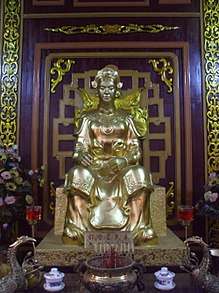
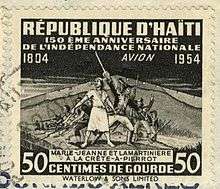
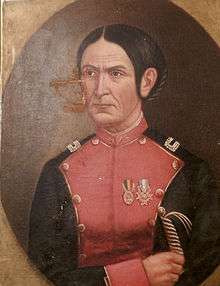

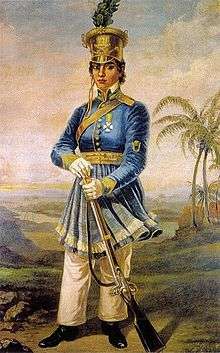


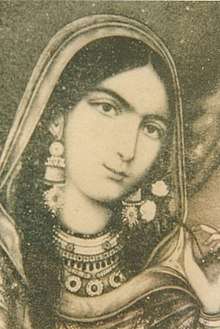
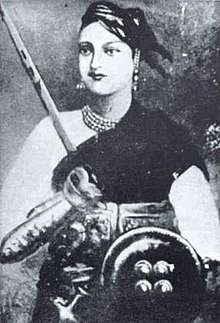


.jpg)

